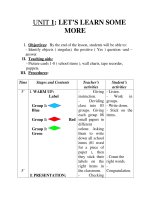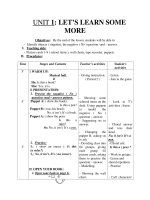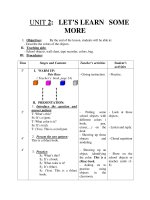HOW ACCOUTING RATIOS AFFECTING AN INVESTOR’S DECISION, SOME CASES OF CONSTRUCTION COMPANIES
Bạn đang xem bản rút gọn của tài liệu. Xem và tải ngay bản đầy đủ của tài liệu tại đây (1.81 MB, 87 trang )
i
HOW ACCOUTING RATIOS AFFECTING AN INVESTOR’S DECISION, SOME
CASES OF CONSTRUCTION COMPANIES
BY
NGUYEN THI KIM THOA
E0600117
BARCHELOR OF BUSINESS (ACCOUNTING) HONS
HELP UNIVERITY COLLEGE
28 MARCH 2011
1
DECLARATION OF ORIGINALITY AND WORD COUNT
I hereby declare that this graduation project is based on my original work except for
quotations and citations which have been duly acknowledged. I also declare that it has
not been previously or concurrently submitted for any other course/degree at Help
University College or other institutions. The word count is 11828 words.
NGUYEN THI KIM THOA
28
th
March 2011
2
ACKNOWLEDGEMENT
This project may not be efficient without the helping, support and encouragement of
many people. I wish to send this opportunity to thank all people who have helped me
during the time of conducting this project.
First of all, I would like to express my deep gratitude to my supervisor Dr. Le Van Lien,
International School, Vietnam National University Hanoi who has kindly helped and
supported me in doing this research process. I also would like to express my thank to Ms.
Sumathi , Help University College, who initiated the project and give so much instruction
and support to this thesis.
Additionally, I would like to thank all investors of 2 companies are Thanh Cuong Co.,
Ltd and Construction, Bridges and Roads No 17 JSC who participated in this survey in
order to conduct this project. I also would like to extend my special thanks to managers,
accountants, my friends, and other people who have help me to carry out the survey. I
want to thank them for all their support, interest and valuable hints.
Last but not least, I would like to express my deep appreciation to my family who
provided and supported me much in commentary which is very important for completing
this project, made for me any chances to conduct this subject in any spare time.
NGUYEN THI KIM THOA
3
HOW ACCOUTING RATIOS AFFECTING AN INVESTOR’S DECISION, SOME
CASES OF CONSTRUCTION COMPANIES
By
NGUYEN THI KIM THOA
March 2011
Supervisor: Dr. Le Van Lien
ABSTRACT
Accounting ratios are values of the relationships between 2 related accounts that appear
in the financial statements such as: income statement, balance sheet, cash flows
statement, and changes in equity. They present a company condition in the previous time,
and predict by how the company will operate in the future. This research works to
evaluate the values of accounting ratios to make investment decisions. By conducting of
standard financial statements, calculating of accounting ratios and comparing these ratios
in variety of companies are a burning issue and crucial mission to investors. As Vietnam
is a developing and urbanizing country, it is a benefit condition for construction industry
to grow. This project aims to discover definitions of accounting or financing ratios also
the calculations of these accounting, and then it shows how of accounting ratios affect on
investor’s decision making. The results of the study provide evidence to measure ratios
and lastly it show out some recommendations and suggestions in applying accounting
ratios in investment decisions to investors.
4
TABLE OF CONTENTS
DECLARATION OF ORGINALITY AND WORD COUNT 1
ACKNOWLEDGEMENT 2
ABSTRACT………………………………………………………………………………3
TABLE OF CONTENTS 4
LIST OF FIGURES 7
LIST OF TABLES 8
LIST OF ABBREVIATIONS 9
CHAPTER 1: INTRODUCTION 11
1.1 Research background 11
1.2 Problem statement 12
1.3 Objective and scope of the research 14
1.3.1 Objective 14
1.3.2 Scope 14
1.4 Research method 14
1.5 Struture of research………………………………………………………… ………15
CHAPTER 2: LITERATURE REVIEW 17
2.1 Financial statements – the important accounting information sources for investors to
calculate accounting ratios. 18
2.1.1 Balance sheet 19
2.1.2 Income statement 20
2.1.3 Cash flow statement 20
2.1.4 Statement of changes in equity. 21
2.2. Value-relevance Literature: definitions of accounting ratios……………………….21
2.2.1. Liquidity ratios 22
2.2.1.1 Current ratio 22
2.2.1.2. Quick ratio 23
5
2.2.2.Profitability ratios 23
2.2.2.1 Gross profit magin. 24
2.2.2.2 Net operating profit magin. 24
2.2.2.3 Return on asset ratio. 25
2.2.3 Activity ratio. 25
2.2.3.1 Inventory turnover ratio. 26
2.2.3.2 Account receivable turnover ratio. 26
2.2.3.3 total asset turnover ratio. 26
2.2.4 Debt ratio. 27
2.2.4.1 Debt ratio. 27
2.2.4.2 Debt to equity ratio. 28
2.3 Disclosure of SWOT model analysis in using of accounting ratios. 28
2.4 The importance and impacts of accounting ratios on making investment decision
process 30
2.5 Disadvantges of using accounting ratios to mesure efficiency of the company 31
2.5.1. Impact of inflation…………………………………… ………………………….31
2.5.2: Window Dressing………………………… …………………………………31
2.5.3. Product Line diversification… ………………………………………………31
2.5.4. Differences in Accounting Policies…………………………… ……………32
CHAPTER 3: RESEARCH AND METHODLOGY 33
3.1 Aims of project………………………………………………………………… 34
3.2 Research Methodology………………………………………………………… 35
3.3 Data sources, which includes………………………………………………… 36
3.3.1. Primary data……………………………………………………………… 36
3.3.2. Secondary data………………………………………………………………36
3.4 Limitation……………………………………………………………………… 37
CHAPTER 4: CASE STUDY ANALYSIS …39
6
4.1 Introduction of 2 example companies……………………………………………….39
4.1.1 Thanh Cuong Limited Company…………………………………………… ……39
4.1.2 Introduction of Construction, Bridges and Roads No 17 Joint Stock
Company……………………………………………………………………………………………40
4.1.3 The management strutures of Thanh Cuong Co.,Ltd and XDCD 17 JSC… … 41
4.2 Presentation and explanation of the 2 companies’ development and financial
statements……………………………………………………………………………… 43
4.3. The facilities and developments of these 2 example companies……………………44
4.3.1.: Thanh Cuong Co., Ltd………………………………… ……………………44
4.3.2. Construction, bridges and roads No 17, Joint Stock Company………………44
4.4. The using of accounting method in conducting financial statements of these 2
companies……………………………………………………………………………… 45
4.5 Missions of these 2 companies in the future………………… ……………………45
4.6. Calculations of these 2 companies’ ratios……………………………………… …45
4.7 The attitude of investors to 2 example companies in investment………………….… 56
CHAPTER 5: CONCLUSION AND RECOMMENDATION 58
5.1 Findings……………………………………………………………………………………… 58
5.2 Conclusion……………………………………………………………………… …59
5.3 Recommendation for computing the accounting ratio of Thanh Cuong Co., Ltd ,
XDCD 17 JSC………………………………………………………………………………….,,,.60
REFERENCES…………………… ………………………………………………,,, 61
APPENDIXES………………………………………………………………………… 64
APPENDIX A: ……………………………………………………………………….66
APPENDIX 1.A Translation of the above data in the picture 1.A into English……… 69
APPENDIX 2.A Translation of the above data in the picture 2.A into English 74
APPENDIX B………………………………………………………………………… 76
7
APPENDIX 1.B Translation of the above data in the picture 1.B into English…77
APPENDIX 2.B Translation of the above data in the picture 2.B into English…81
APPENDIX 3.B Translation of the above data in the picture 3.B into English…85
8
LIST OF FIGURES, DIAGRAM, AND IMAGES
Figure 1 Financial statement 19
Figure 2 SWOT analysis model. 29
Figure 3 Structure of management team in both example company. 41
Diagram 1 Investment decisions of 10 investors in these 2 example companies. 57
Image 1 64
Image 2 . 65
Picture 1.A The balance sheet of Thanh Cuong Co., Ltd as at 31 December, 2009 (data
in Vietnamese language. 66
Picture 2.A Income statement of Thanh Cuong Co., Ltd for the year ended 31
st
Decenber
2009( the data in Vietnamese language ) 72
Picture 1.B The data about fianance of Construction, Bridges and Roads No 17, JSC (in
Vietnamese language). 76
Picture 2.B The balance sheet of XDCD 17 as at 31 December, 2009 (data in
Vietnamese language). 79
Picture 3.B Income statement of XDCD 17 for the year ended 31
st
Decenber 2009( the
data in Vietnamese language) 84
9
LIST OF TABLES
Table 1 46
Table 2. 47
Table 3. 48
Table 4. 49
Table 5 50
Table 6. 51
Table 7. 52
Table 8 53
Table .9 54
Table 10 55
10
LIST OF ABBREVIATIONS
FDI Foreign direct investment.
SOE Statement of Changes in owners’ equity (SOE)
EAT Earnings after taxes
XDCD 17 JSC Construction, Bridges and Roads No 17 Joint Stock Company
C.R Current ratio
QR Quick Ratio
GPMR Gross profit margin ratio
NOPR Net operating profit
ROAR Return on asset ratio
ITR Inventory ratio
ARTR Account receivable turnover ratio
TATR Total assets turnover ratio
D.R Debt ratio
DTER Debt to equity ratio
11
CHAPTER 1: INTRODUCTION
Chapter 1 draws up whole image of the information relate to this project that helps users
easy to follow. It also shows for reader to know about the significant relationship
between financial ratios and investors’ decisions. The introduction of this thesis will
cover all related issues that are listed by some following parts.
1.1 Research background.
After event of joining the World Trade Organization (WTO) in 2007, Vietnam has
become increasingly opened and attractive economy. It attracts more both foreign and
domestic investors from all industries, especially construction fields. To this industry,
Vietnam’s economy becomes emerging market. 2 years since joining WTO, the biggest
advantage to the Real Estate and Construction Industry is FDI that has been rapidly
increasing. In the context of Vietnam that had been being in process of pushing up
modernize, because domestic capital resource had limited, rapidly increasing of FDI in
Real Estate and Construction Industry has had significant role in urbanizing and
upgrading Infrastructure. Today, many foreign investors and domestic investors are
attracted by this industry because of its revenues and profits. But the biggest problem to
these investors is almost reflected by the question: how to make the best decisions in
investment in order to maximize benefit and profit in this industry? One the best solution
is applying accounting ratios analysis to make decisions in the construction industry.
An accounting ratio or financial ratio is a relative magnitude of two mathematical values
that are chosen and got from financial statements of an organization. Accounting or
financial ratios may be used by company’s owners, managers, shareholders, investors,
and a business’ creditors. In the context of stocks market, financial ratios are used to
12
compare the efficiency and weaknesses among the variety of firms.
If stocks in an
organization are listed and traded in a financial market, the stock’s price in the market
will be used in certain financial or accounting ratios.
In general, many areas of an organization are reflected by accounting ratios, these results
of ratios are inherent parts of the financial statement analysis. A business’s performance
is affected so much by these key factors; it can interpret financial information and
position of the company. Moreover, these ratios also help investors know more about
how the business is performing. As a result, it is easier for investors to make best
decisions whether investing in or not in the company.
In accounting, there are 3 methods of comparison ratios that are: comparisons of
accounting ratios between businesses, between different financial time periods of an
entity, and between a significant firms and its industry average in which the firms
belongs to.
Hence, if investors make decisions without accounting ratios analysis, it is very risky to
invest in a new project. Useful financial ratios can be refer as special and efficient tools
to many professional investors, managers, researchers, accountants on many approaches
of investment; it can help users having information to estimate potential, efficient
business as well as its risk in the future to make economic decisions.
1.2 Problem statements.
Accounting ratios calculations and attitude of investors in investment decisions making
are the crucial aims of this project. It will show the advantages and disadvantage of using
13
accounting ratios analysis to an organization, as well as their function on the decision of
investors, users of financial statements, etc.
To know how accounting ratios affecting an investor’s decision, let examine the role of
accounting ratios to investor’s making decisions and establishing best strategies in doing
business.
Accounting ratios or financial ratios firstly provide information of a company about its:
assets ( both current and noncurrent assets), liabilities (both long term and short term
loan), owner’s equity, revenues or sales, income, expenses, profits or losses, cash flows,
ability to pay debt, etc.
Accounting ratios are known as a type of original information that is provided to
investors in construction industry. Using accounting ratios is known as an indication to
know how a business is performing. In doing business, especially in supplying
construction materials firms, accounting or financial ratios are mostly important and
effective tools in financial analysis of the market that help financial analysts know
voltage market, investors implement plans and make better decisions, managers and
sellers apply suitable sale strategies that improve profitability, liquidity, financial
structure, leverage, etc. In general, accounting ratios reflect mostly a business
performance in previous time, but they can predict, and show out lead indications of
latent bad points to investors in the future. For example, applying S.W.O.T analysis in
consideration of comparative ratios analysis between 2 companies in supplying
construction materials industry that are Thanh Cuong .co, Ltd, and XDCD 17 , JSC will
help investors figure out quantity of these 2 companies. From it, investors can evaluate
14
financial position of these companies. Moreover, they can understand the risks they may
be facing in the future when investing in business.
Therefore, accounting ratios are reliable information and mathematic figures where users
and investors can lay their belief in making investment decision.
1.3 Objectives and Scope of the Research:
1.3.1 Objectives:
Consider whether accounting ratios analysis affects the investor’s decision
or not?
The result of the use of accounting ratios analysis by investors in business.
Suggest some solutions to improve accounting ratios analysis that
investors take into this research to make investment decisions.
1.3.2 Scope:
Place involves to conduct this project ( 2 companies in construction
industry )
Thanh Cuong Co., Ltd.
Construction, bridges, and roads, Joint Stock Company
Object of the project: Investors
Time period to do this project: From 28
th
October 2010 to 16 March 2011.
1.4 Research method.
15
Researches methods are used in this thesis are based on the practical research and
investigation.
The author operates the survey of 10 investors (lenders) of the 2
companies: Thanh Cuong co., Ltd, and Construction, bridges, and roads,
Joint Stock Company. The surveys from different areas of accounting
ratios that contain the information and evidence could help the investors of
the 2 companies to make the best decision in investment. This research
follows qualitative method and literature method in which the data is
collected from different areas of accounting ratios of examples companies.
By analyzing of accounting ratios and publishing they to investors in these
2 companies, the investors could know the frequency of the accounting or
financial ratios’ usage to have right decisions in doing business not only in
these firms but also having a new look on investments in the construction
industry.
1.5 Structure of the research.
There are five chapters that are as follow:
Chapter 1: Introduction
Chapter 2: Literature review
Chapter 3: Research and methodology
Chapter 4: Case study analysis
Chapter 5: Conclusion and recommendation
16
Each chapter in the research has linked to another remain chapters in order to express the
main point of view that the researcher want to present.
The first chapter and the third chapter will conduct the background of problem to start up
the main points of this project.
The second chapter will face up with the theories, definitions, and formulas of financial
statements, accounting ratios, SWOT analysis model, strong points, and weak points of
accounting ratios.
Chapter 4 will tell about some real and example cases that are played as a role of
applying literatures and formulas in calculations of accounting ratios that appear in
chapter 2.
And the last chapter will consist of the findings, conclusion, and recommendation after
examining some example cases linked to the theories and definitions.
17
CHAPTER 2: LITERATURE REVIEW
This chapter will present some definitions of accounting ratios. By understanding
financial ratios or accounting ratios can help the investors know what kind and how much
of accounting ratios level they need to make efficient decisions in investment. After that,
SWOT model will be applied to evaluate advantages and disadvantages of using
accounting ratios.
18
2.1 Financial statements – the important accounting information sources for
investors to calculate accounting ratios.
To investors, one of important things in decision making process is existence of quality
information. Significant number of this information comes from accounting information
systems and from financial statements. For almost companies, financial statements
provide realistic and objective picture of realistic business condition. In an organization,
if financial statements are understandable, in which accuracy is ensured. Financial
statements are always created and interpreted as a basis of comparisons. Financial
statements as a main function of decision making, it is understandable that different
users must know how to “read” those statements. “Reading” contents of financial
statements provide whole number of different instruments and analyses procedures for
understanding business. After that, the process of accounting ratios analysis will be
conducted that is based on the basis of the financial statements and financial information
in order to evaluate of the business’ wealth.
Economic and political backgrounds around the world are not the same among
governments; this leads to that the national accounting standards are different among
countries. Decision No. 15/2006 20
th
March 2006 of the Minister of Finance of Vietnam
dictated financial reporting system of business containing both annual financial
statements and interim financial statements. To construction industry, the Decision
No.48/2006 14
th
September 2006 of the Minister of Finance of Vietnam has prescribed in
recent years. Under Vietnam Accounting Standards, the most significant financial
19
statements that should take into account when examining the entire entity quality are:
balance sheet, income statement or profit and loss account, cash flow statement, and
changes in owner’s equity statement. These financial statements will be illustrated by
the following figure:
FINANCIAL STATEMENTS
BALANCE
SHEET
INCOME
STATEMENTS
CASH FLOWS
STATEMENTS
CHANGE IN
OWNERS
Figure 1: Financial statements
2.1.1 The balance sheet.
The balance sheet of a company is one of the extremely essential and fundamental
financial statements that is conducted annually or financial time period to present the
company’s financial position. This statement consists of basic elements are: assets,
liabilities, and owner equity. This structure is very important that reflects the correlation
and interdependence of assets, liabilities and capital. By reading and understanding this
financial statement, users including investors can examine and measure the future scenes
20
and future prediction. Moreover, this statement serves users to have knowledge about an
organization’s liability for tax authorities, employees, internal also external investors,
banks, suppliers, and etc. In this statement, an accounting standard must be followed is
that total assets equals to liabilities plus owner’s equity.
2.1.2 Income statement.
Income statement or profit and loss account represents business' performance for a
particular moment of time period. Basic elements of an organization’s income statement
are: revenues, expenses and the difference between revenues and expenses that can be
profit or loss. In some context, the income statement is the loveliest statement that
attracts investors in making the investment decision. By analyzing and understanding
accounting data comes from this statement, investors can get the financial information
about revenue, cost of goods sold, interest, expenses, gross profit, net profit etc that are
used to calculate the accounting ratios as a tool to draw up the financial situation as well
as the quality of an organization.
2.1.3 Cash flow statement.
Cash flow statement presents cash into or out of a company. "Cash" is used here in the
term of not only cash in hand but also cash transactions of bank deposits or cash
equivalents. This change of cash amount is usually measured during a specified, finite
period of time. By conducting of cash flow statement, investors can use this data for
calculating other areas that give information on the business' value and situation. In
Vietnam, cash flow statement is conducted under Vietnamese Accounting Standards
called No. 24 (VAS 24).Cash flow statement includes accounting data related to three
21
main activities that are: operating activities cash flows, financial activities cash flows,
and investing activities cash flow.
2.1.4 Statement of Changes in owners’ equity (SOE):
The statement of changes in owners’ equity (SOE) can be referred to the statement of
changes in retained earnings, or the statement of changes in capital stock. This financial
statement has some important aspects in common with the profit and loss account or the
income statement because it shows all transaction which refers to profit or loss for
particular time period. This statement consists of two main parts that explained by words:
paid-in capital and retained earnings.
2.2 Value-relevance Literature: definitions of accounting ratios.
A financial ratio or accounting ratio is a measurement that indicates condition of a
business, for example the ratio between the annual sale or revenue and inventory or
between its net sales and its average total assets. The main source of these ratios is from
the company's profit & loss account or income statement and balance sheet that contain
all kinds of accounting data belonging to that business. These accounting ratios really
help to bring those details to light and identify the financial strengths and weaknesses of
the company to mark up business’ strategies in the future.
The process of examining accounting ratios will show the significant relationship with
full meaning among individual values in the financial statements of business. From the
analyzing of ratios, investors will know how to compare these ratios in order to consider
the results of business activities to make better investment option in relation to the entire
22
economy, industry sector, the main competitors in range of the industry, and the previous
performance of the business they are taking into. Mention to this research; let concern to
4 accounting ratios such as: liquidity ratios, profitability ratios, activity ratios, and debt
ratios.
2.2.1 Liquidity ratios.
Liquidity ratios are accounting or financial ratios that reflect condition of a firm's ability
to fulfill its short-term loans, financial debts or liabilities (current liabilities). The
expanding interim credit to the firm is interested in liquidity ratio particularly. Two
common ratios in liquidity ratios that the project want to share are current ratio (or
working capital ratio) and the quick ratio.
2.2.1.1: Current ratio (Working Capital Ratio)
With:
Current Assets equal to net of contingent liabilities on notes receivable
And Current Liabilities equal to all debt due within one year of statement data
Mostly a higher current ratio of a company could reduce short-term creditors’ risk ,
thus almost investors tend to invest in the firm that has a higher current ratio compare
to the other one in the same industry. In converse, shareholders are interested in the
23
company that has a lower current ratio than another one in order to make sure that the
firm’s assets are used efficiently to make the business develop.
2.2.1.2: Acid-test ratio (Quick ratio)
The current assets sometime refer to a disadvantage of a company because its inventories
may are some items that have low liquidated ability and ambiguous liquidation values,
for example banks or investors is not much interested in inventory of the company when
make investment . Therefore, the acid test ratio or the quick ratio is the best solution to
measure liquidity of a company without inventory in the current assets. This ratio can be
calculated by following formula:
2.2.2: Profitability ratios:
In the financial statement of a company, profitability ratios are closely linked with
income ratios, which focus on the overall quality of management and control relating to
the returns generated on revenues and investment. These measurements present the
success of a business in creating profit. This thesis concentrates in 3 different
measurements of accounting ratios are: Gross profit margin on net sales, net operating
profit, and return on assets ratio.
24
2.2.2.1. Gross Profit margin on Net Sales ratio:
This ratio can be called with different names like gross profit ratio or gross margin. Gross
profit margin can be talked as the first measurement for a business. Without doing well at
this benchmark, there is no point looking at any other thing. This is a significant and
important ratio because it evaluates both the efficiency and pricing policy of a business, it
also tells about profit which is the final destination of all the strategies and decisions of a
company, and it is computed by the below formula:
= Gross Profit margin on Net Sales Ratio.
Net Sales - Cost of Goods Sold
Net Sales
2.2.2.2. Net Operating Profit Ratio.
The net operating profit ratio is computed as:
EAT
= Net Profit on Net Sales Ratio.
Net Sales


![hedge fund of funds investing - an investor's guide [2004 isbn1576601242]](https://media.store123doc.com/images/document/14/y/nl/medium_nls1399517730.jpg)






